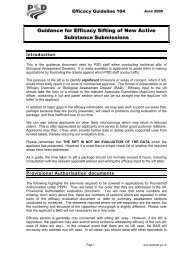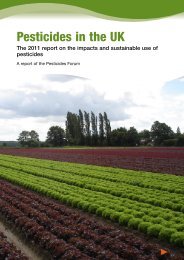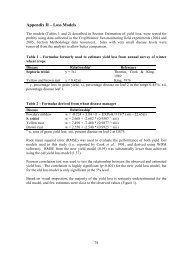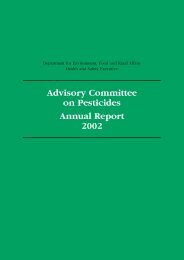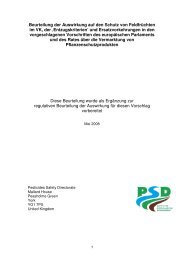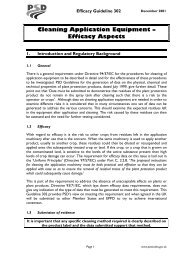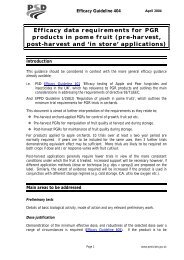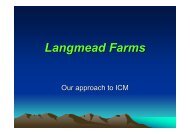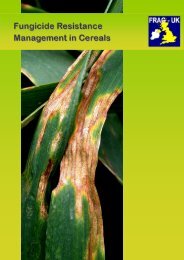Advisory Committee on Pesticides Annual Report 2001
ACP Annual Report 2001 - Pesticides Safety Directorate
ACP Annual Report 2001 - Pesticides Safety Directorate
You also want an ePaper? Increase the reach of your titles
YUMPU automatically turns print PDFs into web optimized ePapers that Google loves.
Secti<strong>on</strong> F: Other items c<strong>on</strong>sidered during the year<br />
accounted for less than <strong>on</strong>e percent of the area of ornamental crops treated<br />
but for 55 percent of the weight applied.<br />
Usage of daminozide accounted for over half of the area of ornamentals<br />
treated with growth regulators. Two fungicides accounted for 41 percent of<br />
the total fungicide-treated area of protected ornamental crops: chlorothal<strong>on</strong>il<br />
21 percent, and iprodi<strong>on</strong>e 20 percent. The organophosphates were again the<br />
most extensively used group of insecticides and accounted for 28 percent of<br />
the insecticide-treated area, the pyrethroids 25 percent and the carbamates<br />
16 percent. The most extensively used individual insecticides were pirimicarb<br />
14 percent, cypermethrin 14 percent, deltamethrin 11 percent, heptenophos<br />
11 percent, dichlorvos ten percent and nicotine nine percent. Two species<br />
accounted for 53 percent of the biological c<strong>on</strong>trol agent treated area: Encarsia<br />
formosa 28 percent and Aphidius colemani 25 percent. Two acaricides<br />
accounted for 85 percent of the acaricide-treated area of ornamental crops,<br />
abamectin 56 percent and bifenthrin 28 percent.<br />
While the area of protected ornamental crops had increased by 84 percent<br />
since 1995, the area treated with registered pesticides increased by 61 percent<br />
over the same period. There had been increases in the use of both fungicides,<br />
64 percent, and insecticides, two percent, between 1995 and 1999. However,<br />
the use of growth regulators, mainly for bedding plants and pot plants, had<br />
increased to ten times the area recorded in 1995. The use of registered and<br />
other biological c<strong>on</strong>trol agents had decreased by 45 percent. In line with the<br />
increases in the areas treated, the weight of registered pesticides applied had<br />
increased by 68 percent since 1995.<br />
67<br />
<strong>Report</strong> 165: Mushroom crops in Great Britain 1999<br />
This report presented informati<strong>on</strong> c<strong>on</strong>cerning all aspects of pesticide usage<br />
<strong>on</strong> mushrooms grown in Great Britain in a 12-m<strong>on</strong>th period during the 1999<br />
growing seas<strong>on</strong>. Data were collected during visits to 61 holdings growing<br />
mushrooms throughout Great Britain, representing 52 percent of total<br />
mushroom producti<strong>on</strong>. The holdings surveyed in each regi<strong>on</strong> were<br />
proporti<strong>on</strong>al to the producti<strong>on</strong> of mushrooms grown in that regi<strong>on</strong> and the<br />
data <strong>on</strong> the area of pesticide treatments and the amount of active substances<br />
applied had been extrapolated to give estimates of nati<strong>on</strong>al usage.<br />
Since 1995 there had been a 39 percent reducti<strong>on</strong> in the producti<strong>on</strong> area of<br />
mushrooms. This has been accompanied by a corresp<strong>on</strong>ding decrease in the<br />
area treated of 40 percent but a reducti<strong>on</strong> in the weight of pesticides applied,<br />
mainly disinfectants, of 90 percent.




